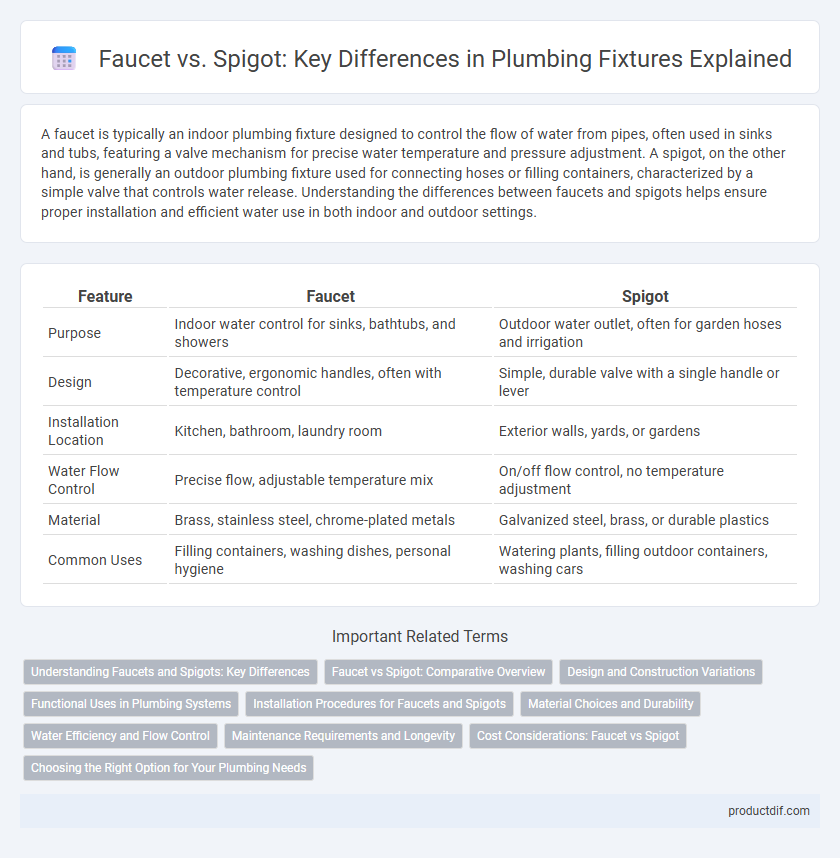A faucet is typically an indoor plumbing fixture designed to control the flow of water from pipes, often used in sinks and tubs, featuring a valve mechanism for precise water temperature and pressure adjustment. A spigot, on the other hand, is generally an outdoor plumbing fixture used for connecting hoses or filling containers, characterized by a simple valve that controls water release. Understanding the differences between faucets and spigots helps ensure proper installation and efficient water use in both indoor and outdoor settings.
Table of Comparison
| Feature | Faucet | Spigot |
|---|---|---|
| Purpose | Indoor water control for sinks, bathtubs, and showers | Outdoor water outlet, often for garden hoses and irrigation |
| Design | Decorative, ergonomic handles, often with temperature control | Simple, durable valve with a single handle or lever |
| Installation Location | Kitchen, bathroom, laundry room | Exterior walls, yards, or gardens |
| Water Flow Control | Precise flow, adjustable temperature mix | On/off flow control, no temperature adjustment |
| Material | Brass, stainless steel, chrome-plated metals | Galvanized steel, brass, or durable plastics |
| Common Uses | Filling containers, washing dishes, personal hygiene | Watering plants, filling outdoor containers, washing cars |
Understanding Faucets and Spigots: Key Differences
Faucets and spigots serve as plumbing fixtures controlling water flow but differ primarily in design and usage, with faucets commonly found indoors for sinks and baths, while spigots are exterior fixtures designed for garden hoses and outdoor water access. Faucets usually incorporate mixers for hot and cold water, providing temperature control, whereas spigots typically deliver cold water only, featuring a simple valve mechanism. Material differences also exist; faucets often use brass or chrome finishes for aesthetic and corrosion-resistant properties, while spigots focus on durability with heavy-duty metals to withstand outdoor elements.
Faucet vs Spigot: Comparative Overview
Faucets and spigots serve as essential plumbing fixtures for controlling water flow, but differ in design and application. Faucets typically feature internal mechanisms such as cartridges or discs for precise indoor water regulation, commonly installed in kitchens and bathrooms. Spigots are outdoor fixtures with a simple valve, designed for durability and ease of use in garden hoses or exterior water outlets.
Design and Construction Variations
Faucets typically feature a compact design with integrated handles or levers for precise water flow control, often constructed from brass or stainless steel for durability and corrosion resistance. Spigots usually have a more robust, utilitarian build with a simple valve mechanism and threaded outlet for hose attachment, commonly made from cast iron or brass to withstand outdoor conditions. The design variations reflect their functional use, with faucets prioritizing aesthetic appeal and ease of use indoors, while spigots emphasize ruggedness and practicality for outdoor water access.
Functional Uses in Plumbing Systems
Faucets and spigots serve distinct functional roles in plumbing systems, where faucets typically control indoor water flow for sinks, bathtubs, and showers with precise temperature and pressure regulation. Spigots, often installed outdoors, provide durable access to water for garden hoses, irrigation, and external cleaning tasks, designed to withstand varying weather conditions. Understanding these differences ensures optimal selection for residential or commercial plumbing needs, enhancing efficiency and water management.
Installation Procedures for Faucets and Spigots
Installation procedures for faucets typically involve connecting to both hot and cold water supply lines, securing the fixture to a sink or countertop, and sealing with plumber's putty or silicone to prevent leaks. Spigot installation is generally simpler, requiring attachment to an outdoor water supply pipe, securing with threaded fittings or hose clamps, and ensuring proper drainage to avoid freezing. Both require shut-off valves and testing for leaks to ensure functionality and durability.
Material Choices and Durability
Faucets are typically constructed from brass or stainless steel, offering superior corrosion resistance and long-lasting durability suitable for indoor use. Spigots, often made from zinc alloy or plastic, prioritize affordability and ease of installation but may compromise on lifespan under harsh outdoor conditions. Selecting high-quality materials for faucets and spigots directly impacts their resistance to wear, corrosion, and environmental factors.
Water Efficiency and Flow Control
Faucets typically offer superior water efficiency due to integrated aerators that reduce flow without compromising pressure, making them ideal for indoor plumbing fixtures. Spigots often provide less precise flow control, designed primarily for outdoor use with higher flow rates and less focus on water conservation. Choosing a faucet over a spigot can significantly lower water consumption by enabling adjustable, low-flow settings that meet environmental standards.
Maintenance Requirements and Longevity
Faucets typically require periodic cartridge or washer replacement due to internal wear, ensuring smooth operation and leak prevention. Spigots, often exposed to harsher outdoor conditions, need regular inspection for freezing damage and corrosion, with maintenance focused on sealing and valve integrity. High-quality materials like brass or stainless steel significantly enhance the longevity of both fixtures, reducing the frequency of repairs and replacements.
Cost Considerations: Faucet vs Spigot
Faucets generally have a higher upfront cost compared to spigots due to their complex design and integrated features, making them a pricier option for indoor plumbing. Spigots are typically more affordable and durable, ideal for outdoor use and less frequent maintenance, which reduces long-term costs. Budget-conscious homeowners often choose spigots for exterior water supply while reserving faucets for indoor applications where aesthetics and functionality justify the investment.
Choosing the Right Option for Your Plumbing Needs
Selecting between a faucet and a spigot depends on the specific plumbing requirements and installation location. Faucets, commonly found indoors, provide precise water control for sinks, bathtubs, and showers, featuring varied designs and finishes to match interior aesthetics. Spigots, typically outdoor fixtures, offer durable water access for garden hoses and irrigation, designed to withstand weather exposure and support higher flow rates for outdoor tasks.
Faucet vs Spigot Infographic

 productdif.com
productdif.com